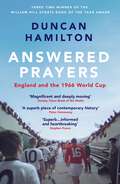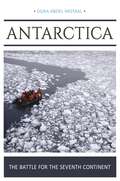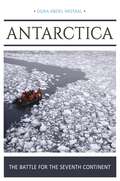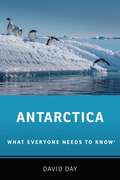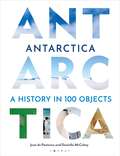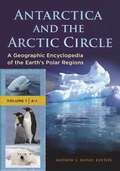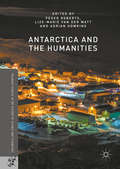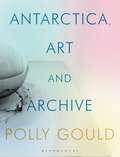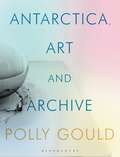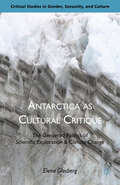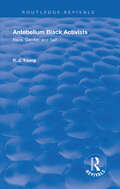- Table View
- List View
Ansgar, Rimbert and the Forged Foundations of Hamburg-Bremen (Church, Faith and Culture in the Medieval West)
by Eric KnibbsAnsgar and Rimbert, ninth-century bishops and missionaries to Denmark and Sweden, are fixtures of medieval ecclesiastical history. Rare is the survey that does not pause to mention their work among the pagan peoples of the North and their foundation of an archdiocese centered at Hamburg and Bremen. But Ansgar and Rimbert were also clever forgers who wove a complex tapestry of myths and half-truths about themselves and their mission. They worked with the tacit approval-if not the outright cooperation-of kings and popes to craft a fictional account of Ansgar's life and work. The true story, very different from that found in our history books, has never been told: Ansgar did not found any archdiocese at all. Rather, the idea of Hamburg-Bremen only took root in the tenth century, and royal sponsorship of the mission to Denmark and Sweden ended with the death of Louis the Pious. This book couples detailed philological and diplomatic analysis with broader historical contextualization to overturn the consensus view on the basic reliability of the foundation documents and Rimbert's Vita Anskarii. By revising our understanding of Carolingian northeastern expansion after Charlemagne, it provides new insight into the political and ecclesiastical history of early medieval Europe.
Ansgar, Rimbert and the Forged Foundations of Hamburg-Bremen (Church, Faith and Culture in the Medieval West)
by Eric KnibbsAnsgar and Rimbert, ninth-century bishops and missionaries to Denmark and Sweden, are fixtures of medieval ecclesiastical history. Rare is the survey that does not pause to mention their work among the pagan peoples of the North and their foundation of an archdiocese centered at Hamburg and Bremen. But Ansgar and Rimbert were also clever forgers who wove a complex tapestry of myths and half-truths about themselves and their mission. They worked with the tacit approval-if not the outright cooperation-of kings and popes to craft a fictional account of Ansgar's life and work. The true story, very different from that found in our history books, has never been told: Ansgar did not found any archdiocese at all. Rather, the idea of Hamburg-Bremen only took root in the tenth century, and royal sponsorship of the mission to Denmark and Sweden ended with the death of Louis the Pious. This book couples detailed philological and diplomatic analysis with broader historical contextualization to overturn the consensus view on the basic reliability of the foundation documents and Rimbert's Vita Anskarii. By revising our understanding of Carolingian northeastern expansion after Charlemagne, it provides new insight into the political and ecclesiastical history of early medieval Europe.
Ansprache bei der Gedenkfeier zu Ehren der gefallenen Lehrer und Schüler des Bismarck-Gymnasiums zu Berlin — Wilmersdorf am 22. November 1919
by Fritz ZickermannDieser Buchtitel ist Teil des Digitalisierungsprojekts Springer Book Archives mit Publikationen, die seit den Anfängen des Verlags von 1842 erschienen sind. Der Verlag stellt mit diesem Archiv Quellen für die historische wie auch die disziplingeschichtliche Forschung zur Verfügung, die jeweils im historischen Kontext betrachtet werden müssen. Dieser Titel erschien in der Zeit vor 1945 und wird daher in seiner zeittypischen politisch-ideologischen Ausrichtung vom Verlag nicht beworben.
Anstiften zur guten Tat: Die »Aktion Gemeinsinn« und die westdeutsche Zivilgesellschaft, 1957-2014 (Histoire #217)
by Anja KafurkeDie 1957 gegründete »Aktion Gemeinsinn e.V.« förderte die Zivilgesellschaft und das bürgerschaftliche Engagement in Deutschland, indem sie Werbekampagnen für gemeinnützige Zwecke in den Massenmedien veröffentlichte. Basierend auf einem breiten Quellenkorpus untersucht Anja Kafurke erstmals das Wirken dieser zivilgesellschaftlichen Initiative über einen Zeitraum von knapp 60 Jahren. In einem diskursanalytischen Zugriff nimmt sie die Werbekampagnen als solche sowie die Gesellschaft, in der diese produziert und rezipiert werden, in den Blick. So entsteht ein umfassender Beitrag zur Erforschung der Zivilgesellschaft, der auch den Blick für heutige Debatten und Entwicklungen schärft.
Answered Prayers: England and the 1966 World Cup
by Duncan HamiltonEngland. 1966. The World Cup.Duncan Hamilton watched England beat West Germany as an eight-year-old boy in the company of his father and grandfather. He recalls 'Wembley, spread out in the sun; the waving flags; the delirious, joy-of-all-joys moment of the final whistle; the trophy sparkling in the late afternoon light'.But, seeing the whole game again during the misery of the first Covid lockdown, finally made him realise what Alf Ramsey and his players had no inkling of, which was what came next for them. How, for many of those boys of summer, almost everything after that shimmering moment amounted to an anti-climax or a setback. How '66 was not a beginning, a guaranteed path towards more success, but a slow decline and fall, and also a disproportionate number of disappointments. And how the triumph of '66 was dulled through constant repetition, the same images always flashed before us.Hamilton recognised, too, how many myths and misconceptions had grown around the match. He decided to revisit '66, tracing the very roots of a story - as well as the hidden figures within it - that really began during the era of post-War austerity.Answered Prayers provides, at last, a full account of English football's greatest achievement and the failures that followed it. We see the institutional inability to appreciate Ramsey and his players, who were taken for granted; the political machinations of the blazered fools who ran the Football Association; the short-sighted blunderers of the Football League.With his matchless insight and descriptive power, Hamilton tells history afresh and shows us, for the first time, the scale of what was won and what was lost.PRAISE FOR DUNCAN HAMILTON'Hamilton has a perceptively humane understanding of men for whom football was never just a game' Guardian'A marriage of prose and detail so fine and fastidious that it takes the breath away' Independent'Justifiably prize-winning' Mail on Sunday
Answering the Call: Popular Islamic Activism in Sadat's Egypt (Religion and Global Politics)
by Abdullah Al-ArianWhen revolutionary hero Gamal Abdel Nasser dismantled and suppressed Egypt's largest social movement organization during the 1950s, few could have imagined that the Muslim Brotherhood would not only reemerge, but could one day compete for the presidency in the nation's first ever democratic election. While there is no shortage of analyses of the Muslim Brotherhood's recent political successes and failures, no study has investigated the organization's triumphant return from the dustbin of history. Answering the Call examines the means by which the Muslim Brotherhood was reconstituted during Anwar al-Sadat's presidency. Through analysis of structural, ideological, and social developments during this period in the history of the Islamic movement, a more accurate picture of the so-called "Islamic resurgence" develops-one that represents the rebirth of an old idea in a new setting. The Muslim Brotherhood's success in rebuilding its organization rested in large part on its ability to attract a new generation of Islamic activists that had come to transform Egypt's colleges and universities into a hub for religious contention against the state. Led by groups such as al-Gama'ah al-Islamiyyah (The Islamic Society), the student movement exhibited a dynamic and vibrant culture of activism that found inspiration in a multitude of intellectual and organizational sources, of which the Muslim Brotherhood was only one. By the close of the 1970s, however, internal divisions over ideology and strategy led to the rise of factionalism within the student movement. A majority of student leaders opted to expand the scope of their activist mission by joining the Muslim Brotherhood, rejuvenating the struggling organization, and launching a new phase in its history. Answering the Call is an original study of the history of this dynamic and vibrant period of modern Egyptian history, giving readers a fresh understanding of one of Egypt's most pivotal eras.
Answers in the Form of Questions: A Definitive History and Insider's Guide to Jeopardy!
by Claire McNearWhat is the smartest, most celebrated game show of all time? In this insider's guide, discover the rich history of Jeopardy! -- the beloved game show that has shaped our culture and entertained audiences for years.Jeopardy! is a lot of things: record-setting game show, beloved family tradition, and proving ground for many of North America's best and brightest. Nearly four decades into its current edition, Jeopardy! now finds itself facing unprecedented change.This is the chronicle of how the show became a cross-generational touchstone and where it's going next. ANSWERS IN THE FORM OF QUESTIONS dives deep behind the scenes, with longtime host Alex Trebek talking about his life and legacy and the show's producers and writers explaining how they put together the nightly game. Readers will travel to bar trivia showdowns with the show's biggest winners and training sessions with trivia whizzes prepping for their shot onstage. And they'll discover new tales of the show's most notable moments-like the time the Clue Crew almost slid off a glacier-and learn how celebrity cameos and Saturday Night Live spoofs built a television mainstay. ANSWERS IN THE FORM OF QUESTIONS looks to the past -- and the future -- to explain what Jeopardy! really is: a tradition unlike any other. p.p1 {margin: 0.0px 0.0px 0.0px 0.0px; font: 12.0px 'Times New Roman'} p.p2 {margin: 0.0px 0.0px 0.0px 0.0px; text-indent: 36.0px; font: 12.0px 'Times New Roman'; min-height: 15.0px} p.p3 {margin: 0.0px 0.0px 0.0px 0.0px; font: 12.0px 'Times New Roman'; min-height: 15.0px}
Antarctica: The Battle for the Seventh Continent
by Doaa Abdel-MotaalThe thawing Antarctic continent offers living space and marine and mineral resources that were previously inaccessible. This book discusses how revisiting the Antarctic Treaty System and dividing up the continent preemptively could spare the world serious conflict.The Antarctic Treaty and related agreements—collectively known as the Antarctic Treaty System (ATS)—regulate the seventh continent, which is the only continent without a native human population. The main treaty within the ATS came into force in 1961 and suspended all territorial claims in Antarctica. The Antarctic Environmental Protocol followed in 1998 and prohibited any minerals exploitation in the continent. With this prohibition up for review in 2048, this book asks whether the Antarctic Treaty can continue to protect Antarctica. Doaa Abdel-Motaal—an expert on environmental issues who has traveled through the Arctic and Antarctic—explains that the international community must urgently turn its attention to examining how to divide up the thawing continent in a peaceful manner. She discusses why the Antarctic Treaty is unlikely to be an adequate measure in the face of international competition for invaluable resources in the 21st century. She argues that factors such as global warming, the growth in climate refugees that the world is about to witness, and the increasingly critical quest for energy resources will make the Antarctic continent a highly sought-after objective.Readers will come to appreciate that what has likely protected Antarctica so far was not the Antarctic Treaty but the continent's harsh climate and isolation. With Antarctica potentially becoming habitable only a few decades from now, revisiting the Antarctic Treaty in favor of an orderly division of the continent is likely to be the best plan for avoiding costly conflict.
Antarctica: The Battle for the Seventh Continent
by Doaa Abdel-MotaalThe thawing Antarctic continent offers living space and marine and mineral resources that were previously inaccessible. This book discusses how revisiting the Antarctic Treaty System and dividing up the continent preemptively could spare the world serious conflict.The Antarctic Treaty and related agreements—collectively known as the Antarctic Treaty System (ATS)—regulate the seventh continent, which is the only continent without a native human population. The main treaty within the ATS came into force in 1961 and suspended all territorial claims in Antarctica. The Antarctic Environmental Protocol followed in 1998 and prohibited any minerals exploitation in the continent. With this prohibition up for review in 2048, this book asks whether the Antarctic Treaty can continue to protect Antarctica. Doaa Abdel-Motaal—an expert on environmental issues who has traveled through the Arctic and Antarctic—explains that the international community must urgently turn its attention to examining how to divide up the thawing continent in a peaceful manner. She discusses why the Antarctic Treaty is unlikely to be an adequate measure in the face of international competition for invaluable resources in the 21st century. She argues that factors such as global warming, the growth in climate refugees that the world is about to witness, and the increasingly critical quest for energy resources will make the Antarctic continent a highly sought-after objective.Readers will come to appreciate that what has likely protected Antarctica so far was not the Antarctic Treaty but the continent's harsh climate and isolation. With Antarctica potentially becoming habitable only a few decades from now, revisiting the Antarctic Treaty in favor of an orderly division of the continent is likely to be the best plan for avoiding costly conflict.
Antarctica: What Everyone Needs to Know® (What Everyone Needs To Know®)
by David DayIn this addition to the What Everyone Needs to Know® series, David Day examines the most forbidding and formidably inaccessible continent on Earth. For over a century following its discovery by European explorers in 1820, Antarctica played host to competing claims by rival nations vying for access to the frozen land's vast marine resources -- namely the skins and oils of seals and whales. Though the Antarctic Treaty of 1959 was meant to end this contention, countries have found other means of extending control over the land, with scientific bases establishing at least symbolic claims. Exploration and drilling by the United States, Great Britain, Russia, Japan, and others has led to discoveries about the world's climate in centuries past -- and in the process intimations of its alarming future. Delving into all the relevant issues -- the history of the continent, its wildlife, underwater mountain ranges, arguments over governance, and the continent's effect on global climate change -- Day's work sheds new light on a territory that, despite being the coldest, driest, and windiest continent in the world, will continue to be the object of intense speculation and competition. With new evidence that Antarctica's ice is melting three times faster than it was a decade ago, the need to understand the world's southernmost region has never been more pressing.
Antarctica: A History in 100 Objects
by Jean de Pomereu Daniella McCaheyThis stunning and powerfully relevant book tells the history of Antarctica through 100 varied and fascinating objects drawn from collections around the world.Retracing the history of Antarctica through 100 varied and fascinating objects drawn from collections across the world, this beautiful and absorbing book is published to coincide with the 250th anniversary of the first crossing into the Antarctic Circle by James Cook aboard Resolution, on 17th January 1773. It presents a gloriously visual history of Antarctica, from Terra Incognita to the legendary expeditions of Shackleton and Scott, to the frontline of climate change. One of the wildest and most beautiful places on the planet, Antarctica has no indigenous population or proprietor. Its awe-inspiring landscapes – unknown until just two centuries ago – have been the backdrop to feats of human endurance and tragedy, scientific discovery, and environmental research. Sourced from polar institutions and collections around the world, the objects that tell the story of this remarkable continent range from the iconic to the exotic, from the refreshingly mundane to the indispensable: - snow goggles adopted from Inuit technology by Amundsen - the lifeboat used by Shackleton and his crew- a bust of Lenin installed by the 3rd Soviet Antarctic Expedition- the Polar Star aircraft used in the first trans-Antarctic flight- a sealing club made from the penis bone of an elephant seal- the frozen beard as a symbol of Antarctic heroism and masculinity- ice cores containing up to 800,000 years of climate history This stunning book is both endlessly fascinating and a powerful demonstration of the extent to which Antarctic history is human history, and human future too.
Antarctica: A History in 100 Objects
by Jean de Pomereu Daniella McCaheyThis stunning and powerfully relevant book tells the history of Antarctica through 100 varied and fascinating objects drawn from collections around the world.Retracing the history of Antarctica through 100 varied and fascinating objects drawn from collections across the world, this beautiful and absorbing book is published to coincide with the 250th anniversary of the first crossing into the Antarctic Circle by James Cook aboard Resolution, on 17th January 1773. It presents a gloriously visual history of Antarctica, from Terra Incognita to the legendary expeditions of Shackleton and Scott, to the frontline of climate change. One of the wildest and most beautiful places on the planet, Antarctica has no indigenous population or proprietor. Its awe-inspiring landscapes – unknown until just two centuries ago – have been the backdrop to feats of human endurance and tragedy, scientific discovery, and environmental research. Sourced from polar institutions and collections around the world, the objects that tell the story of this remarkable continent range from the iconic to the exotic, from the refreshingly mundane to the indispensable: - snow goggles adopted from Inuit technology by Amundsen - the lifeboat used by Shackleton and his crew- a bust of Lenin installed by the 3rd Soviet Antarctic Expedition- the Polar Star aircraft used in the first trans-Antarctic flight- a sealing club made from the penis bone of an elephant seal- the frozen beard as a symbol of Antarctic heroism and masculinity- ice cores containing up to 800,000 years of climate history This stunning book is both endlessly fascinating and a powerful demonstration of the extent to which Antarctic history is human history, and human future too.
Antarctica: An Intimate Portrait of the World's Most Mysterious Continent
by Gabrielle WalkerThere have been many books about Antarctica in the past, but all have focused on only one aspect of the continent - its science, its wildlife, the heroic age of exploration, personal experiences or the sheer awesome beauty of the landscape, for example - but none has managed to capture whole story, till now.Gabrielle Walker, author, consultant to New Scientist and regular broadcaster with the BBC has written a book unlike any that has ever been written about the continent. Antarctica weaves all the significant threads into an intricate tapestry, made up of science, natural history, poetry, epic history, what it feels like to be there and why it draws so many different kinds of people back there again and again. It is only when all the parts come together that the underlying truths of the continent emerge. Antarctica is the most alien place on Earth, the only part of our planet where humans could never survive unaided. It is truly like walking on another planet. And yet, in its silence, its agelessness and its mysteries lie the secrets of our past, and of our future.
Antarctica and the Arctic Circle [2 volumes]: A Geographic Encyclopedia of the Earth's Polar Regions [2 volumes]
by Andrew J. HundThis one-stop reference is a perfect resource for anyone interested in the North and South Poles, whether their interest relates to history, wildlife, or the geography of these regions in the news today.Global warming, a hot topic among scholars of geography and science, has led to increased interest in studying the earth's polar ice caps, which seem to be melting at an alarming rate. This accessible, two-volume encyclopedia lays a foundation for understanding global warming and other issues related to the North and South Poles. Approximately 350 alphabetically arranged, user-friendly entries treat key terms and topics, important expeditions, major figures, territorial disputes, and much more.Readers will find information on the explorations of Cook, Scott, Amundsen, and Peary; articles on humpback whales, penguins, and polar bears; and explanations of natural phenomena like the Aurora Australis and the polar night. Expedition tourism is covered, as is climate change. Ideal for high school and undergraduate students studying geography, social studies, history, and earth science, the encyclopedia will provide a better understanding of these remote and unfamiliar lands and their place in today's world.
Antarctica and the Arctic Circle [2 volumes]: A Geographic Encyclopedia of the Earth's Polar Regions [2 volumes]
This one-stop reference is a perfect resource for anyone interested in the North and South Poles, whether their interest relates to history, wildlife, or the geography of these regions in the news today.Global warming, a hot topic among scholars of geography and science, has led to increased interest in studying the earth's polar ice caps, which seem to be melting at an alarming rate. This accessible, two-volume encyclopedia lays a foundation for understanding global warming and other issues related to the North and South Poles. Approximately 350 alphabetically arranged, user-friendly entries treat key terms and topics, important expeditions, major figures, territorial disputes, and much more.Readers will find information on the explorations of Cook, Scott, Amundsen, and Peary; articles on humpback whales, penguins, and polar bears; and explanations of natural phenomena like the Aurora Australis and the polar night. Expedition tourism is covered, as is climate change. Ideal for high school and undergraduate students studying geography, social studies, history, and earth science, the encyclopedia will provide a better understanding of these remote and unfamiliar lands and their place in today's world.
Antarctica and the Humanities (Palgrave Studies in the History of Science and Technology)
by Peder Roberts Lize-Marié Watt Adrian HowkinsThe continent for science is also a continent for the humanities. Despite having no indigenous human population, Antarctica has been imagined in powerful, innovative, and sometimes disturbing ways that reflect politics and culture much further north. Antarctica has become an important source of data for natural scientists working to understand global climate change. As this book shows, the tools of literary studies, history, archaeology, and more, can likewise produce important insights into the nature of the modern world and humanity more broadly.
Antarctica, Art and Archive: The Polar Expeditions Of Edward Wilson
by Polly GouldAntarctica, that icy wasteland and extreme environment at the ends of the earth, was - at the beginning of the 20th century - the last frontier of Victorian imperialism, a territory subjected to heroic and sometimes desperate exploration. Now, at the start of the 21st century, Antarctica is the vulnerable landscape behind iconic images of climate change. In this genre-crossing narrative Gould takes us on a journey to the South Pole, through art and archive. Through the life and tragic death of Edward Wilson, polar explorer, doctor, scientist and artist, and his watercolours, and through the work of a pioneer of modern anthropology and opponent of scientific racism, Franz Boas, Gould exposes the legacies of colonialism and racial and gendered identities of the time. Antarctica, the White Continent, far from being a blank - and white - canvas, is revealed to be full of colour. Gould argues that the medium matters and that the practices of observation in art, anthropology and science determine how we see and what we know. Stories of exploration and open-air watercolour painting, of weather experiments and ethnographic collecting, of evolution and extinction, are interwoven to raise important questions for our times. Revisiting Antarctica through the archive becomes the urgent endeavour to imagine an inhabitable planetary future.
Antarctica, Art and Archive
by Polly GouldAntarctica, that icy wasteland and extreme environment at the ends of the earth, was - at the beginning of the 20th century - the last frontier of Victorian imperialism, a territory subjected to heroic and sometimes desperate exploration. Now, at the start of the 21st century, Antarctica is the vulnerable landscape behind iconic images of climate change. In this genre-crossing narrative Gould takes us on a journey to the South Pole, through art and archive. Through the life and tragic death of Edward Wilson, polar explorer, doctor, scientist and artist, and his watercolours, and through the work of a pioneer of modern anthropology and opponent of scientific racism, Franz Boas, Gould exposes the legacies of colonialism and racial and gendered identities of the time. Antarctica, the White Continent, far from being a blank - and white - canvas, is revealed to be full of colour. Gould argues that the medium matters and that the practices of observation in art, anthropology and science determine how we see and what we know. Stories of exploration and open-air watercolour painting, of weather experiments and ethnographic collecting, of evolution and extinction, are interwoven to raise important questions for our times. Revisiting Antarctica through the archive becomes the urgent endeavour to imagine an inhabitable planetary future.
Antarctica as Cultural Critique: The Gendered Politics of Scientific Exploration and Climate Change (Critical Studies in Gender, Sexuality, and Culture)
by E. GlasbergArguing that Antarctica is the most mediated place on earth and thus an ideal location for testing the limits of bio-political management of population and place, this book remaps national and postcolonial methods and offers a new look on a 'forgotten' continent now the focus of ecological concern.
ANTARCTICA WENK C: What Everyone Needs to Know® (What Everyone Needs To Know®)
by David DayIn this addition to the What Everyone Needs to Know® series, David Day examines the most forbidding and formidably inaccessible continent on Earth. For over a century following its discovery by European explorers in 1820, Antarctica played host to competing claims by rival nations vying for access to the frozen land's vast marine resources -- namely the skins and oils of seals and whales. Though the Antarctic Treaty of 1959 was meant to end this contention, countries have found other means of extending control over the land, with scientific bases establishing at least symbolic claims. Exploration and drilling by the United States, Great Britain, Russia, Japan, and others has led to discoveries about the world's climate in centuries past -- and in the process intimations of its alarming future. Delving into all the relevant issues -- the history of the continent, its wildlife, underwater mountain ranges, arguments over governance, and the continent's effect on global climate change -- Day's work sheds new light on a territory that, despite being the coldest, driest, and windiest continent in the world, will continue to be the object of intense speculation and competition. With new evidence that Antarctica's ice is melting three times faster than it was a decade ago, the need to understand the world's southernmost region has never been more pressing.
Antebellum American Pendant Paintings: New Ways of Looking (Routledge Research in Art History)
by Wendy N. IkemotoAntebellum American Pendant Paintings: New Ways of Looking marks the first sustained study of pendant paintings: discrete images designed as a pair. It opens with a broad overview that anchors the form in the medieval diptych, religious history, and aesthetic theory and explores its cultural and historical resonance in the 19th-century United States. Three case studies examine how antebellum American artists used the pendant format in ways revelatory of their historical moment and the aesthetic and cultural developments in which they partook. The case studies on John Quidor’s Rip Van Winkle and His Companions at the Inn Door of Nicholas Vedder (1839) and The Return of Rip Van Winkle (1849) and Thomas Cole’s Departure and Return (1837) shed new light on canonical antebellum American artists and their practices. The chapter on Titian Ramsay Peale’s Kilauea by Day and Kilauea by Night (1842) presents new material that pushes the geographical boundaries of American art studies toward the Pacific Rim. The book contributes to American art history the study of a characteristic but as yet overlooked format and models for the discipline a new and productive framework of analysis focused on the fundamental yet complex way images work back and forth with one another.
Antebellum American Pendant Paintings: New Ways of Looking (Routledge Research in Art History)
by Wendy N. IkemotoAntebellum American Pendant Paintings: New Ways of Looking marks the first sustained study of pendant paintings: discrete images designed as a pair. It opens with a broad overview that anchors the form in the medieval diptych, religious history, and aesthetic theory and explores its cultural and historical resonance in the 19th-century United States. Three case studies examine how antebellum American artists used the pendant format in ways revelatory of their historical moment and the aesthetic and cultural developments in which they partook. The case studies on John Quidor’s Rip Van Winkle and His Companions at the Inn Door of Nicholas Vedder (1839) and The Return of Rip Van Winkle (1849) and Thomas Cole’s Departure and Return (1837) shed new light on canonical antebellum American artists and their practices. The chapter on Titian Ramsay Peale’s Kilauea by Day and Kilauea by Night (1842) presents new material that pushes the geographical boundaries of American art studies toward the Pacific Rim. The book contributes to American art history the study of a characteristic but as yet overlooked format and models for the discipline a new and productive framework of analysis focused on the fundamental yet complex way images work back and forth with one another.
Antebellum Black Activists: Race, Gender, and Self
by R. J. YoungFirst published in 1996. In this volume the author has collected several published works to explore the ideas of manhood in America, Sojourner Truth, ties of ordinary blacks to those still in slavery and a study of the Northern African American community; new information on black activities in Canada and begins with an essay on the five elements of black community activity before the Civil War: churches, newspapers, conventions, organizations, and emigration which looks at of these "platforms for change" going through developmental stages from experimentation, adjustment and reaching maturity in the 1850’s.
Antebellum Black Activists: Race, Gender, and Self
by R. J. YoungFirst published in 1996. In this volume the author has collected several published works to explore the ideas of manhood in America, Sojourner Truth, ties of ordinary blacks to those still in slavery and a study of the Northern African American community; new information on black activities in Canada and begins with an essay on the five elements of black community activity before the Civil War: churches, newspapers, conventions, organizations, and emigration which looks at of these "platforms for change" going through developmental stages from experimentation, adjustment and reaching maturity in the 1850’s.



